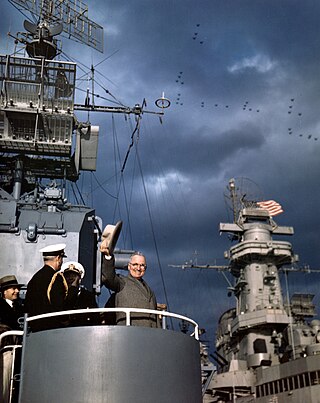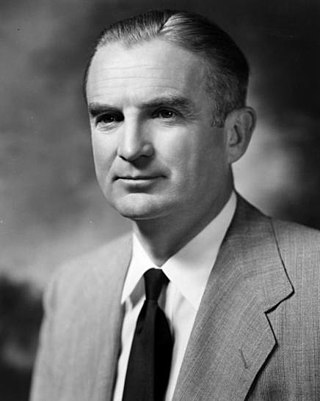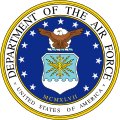
The United States secretary of defense (SecDef) is the head of the United States Department of Defense, the executive department of the U.S. Armed Forces, and is a high-ranking member of the federal cabinet. The secretary of defense's position of command and authority over the military is second only to that of the president of the United States, who is the commander-in-chief. This position corresponds to what is generally known as a defense minister in many other countries. The secretary of defense is appointed by the president with the advice and consent of the Senate, and is by custom a member of the Cabinet and by law a member of the National Security Council.

The Posse Comitatus Act is a United States federal law signed on June 18, 1878, by President Rutherford B. Hayes which limits the powers of the federal government in the use of federal military personnel to enforce domestic policies within the United States. Congress passed the Act as an amendment to an army appropriation bill following the end of Reconstruction and updated it in 1956, 1981 and 2021.

Louis Arthur Johnson was an American politician and attorney who served as the second United States Secretary of Defense from 1949 to 1950. He was the Assistant Secretary of War from 1937 to 1940 and the 15th national commander of the American Legion from 1932 to 1933.

The Prisoner of War Medal is a military award of the United States Armed Forces which was authorized by Congress and signed into law by President Ronald Reagan on 8 November 1985. The United States Code citation for the POW Medal statute is 10 U.S.C. § 1128.

The Committee on Armed Services is a committee of the United States Senate empowered with legislative oversight of the nation's military, including the Department of Defense, military research and development, nuclear energy, benefits for members of the military, the Selective Service System and other matters related to defense policy. The Armed Services Committee was created as a result of the Legislative Reorganization Act of 1946 following the U.S. victory in the Second World War. The bill merged the responsibilities of the Committee on Naval Affairs and the Committee on Military Affairs.

The Goldwater–Nichols Department of Defense Reorganization Act of October 4, 1986 made the most sweeping changes to the United States Department of Defense since the department was established in the National Security Act of 1947 by reworking the command structure of the U.S. military. It increased the powers of the chairman of the Joint Chiefs of Staff and implemented some of the suggestions from the Packard Commission, commissioned by President Reagan in 1985. Among other changes, Goldwater–Nichols streamlined the military chain of command, which now runs from the president through the secretary of defense directly to combatant commanders, bypassing the service chiefs. The service chiefs were assigned to an advisory role to the president and the secretary of defense, and given the responsibility for training and equipping personnel for the unified combatant commands.

The United States Department of the Navy (DON) is one of the three military departments within the Department of Defense of the United States of America. It was established by an Act of Congress on 30 April 1798, at the urging of Secretary of War James McHenry, to provide a government organizational structure to the United States Navy (USN); since 1834, it has exercised jurisdiction over the U.S. Marine Corps (USMC) and, during wartime, the U.S. Coast Guard (USCG), though each remains an independent service branch. It is led by the secretary of the Navy (SECNAV), a statutory civilian officer.

The "Revolt of the Admirals" was a policy and funding dispute within the United States government during the Cold War in 1949, involving a number of retired and active-duty United States Navy admirals. These included serving officers Admiral Louis E. Denfeld, Chief of Naval Operations, and Vice Admiral Gerald F. Bogan, as well as Fleet Admirals Chester Nimitz and William Halsey, senior officers during World War II.

William Stuart Symington III was an American businessman and Democratic politician from Missouri. He served as the first Secretary of the Air Force from 1947 to 1950 and was a United States Senator from Missouri from 1953 to 1976.

The 81st United States Congress was a meeting of the legislative branch of the United States federal government, composed of the United States Senate and the United States House of Representatives. It met in Washington, D.C. from January 3, 1949, to January 3, 1951, during the fifth and sixth years of Harry S. Truman's presidency.

The 80th United States Congress was a meeting of the legislative branch of the United States federal government, composed of the United States Senate and the United States House of Representatives. It met in Washington, D.C. from January 3, 1947, to January 3, 1949, during the third and fourth years of Harry S. Truman's presidency. The apportionment of seats in this House of Representatives was based on the 1940 United States census.

Francis Patrick Matthews was an American who served as the 8th Supreme Knight of the Knights of Columbus from 1939 to 1945, the 50th United States Secretary of the Navy from 1949 to 1951, and United States Ambassador to Ireland from 1951 to 1952.
Women's Armed Services Integration Act is a United States law that enabled women to serve as permanent, regular members of the armed forces in the Army, Navy, Marine Corps, and the recently formed Air Force. Prior to this act, women, with the exception of nurses, served in the military only in times of war. During World War II, over 150,000 women had served in the WAVES and the Women's Auxiliary Army Corps and were still serving when the act was enacted. Women also took part in the SPARS, which was created by the Coast Guard, and the Marine Corps Women's Reserve, during the war. In total, 350,000 American women joined and served during World War II. Section 502 of the act limited service of women by excluding them from aircraft and vessels of the Navy that might engage in combat.
The Hughes–Ryan Amendment was an amendment to the Foreign Assistance Act of 1961, passed as section 32 of the Foreign Assistance Act of 1974. The amendment was named for its co-authors, Senator Harold E. Hughes (D-Iowa) and Representative Leo Ryan (D-CA). The amendment required the President of the United States to report all covert actions of the Central Intelligence Agency to one or more Congressional committees.

The ROA is a professional association of commissioned officers, non-commissioned officers, former officers, enlisted and spouses of the uniformed services of the United States, primarily with the Reserve and National Guard.

The United States Department of Defense is an executive branch department of the federal government of the United States charged with coordinating and supervising all agencies and functions of the U.S. government directly related to national security and the United States Armed Forces. As of June 2022, the U.S. Department of Defense is the largest employer in the world, with over 1.34 million active-duty service members, including soldiers, marines, sailors, airmen, and guardians. DoD also maintains over 778,000 National Guard and reservists, and over 747,000 civilians bringing the total to over 2.87 million employees. Headquartered at the Pentagon in Arlington County, Virginia, just outside Washington, D.C., DoD's stated mission is to provide "the military forces needed to deter war and ensure our nation's security".

Robert F. Hale was the United States Under Secretary of Defense (Comptroller) from 2009 until 2014 and before that the Comptroller and Assistant Secretary of the Air Force for Financial Management. Hale has over thirty years of experience as a professional financial manager serving in a wide range of national defense related roles. In addition to his most recent position as Under Secretary of Defense and his previous appointment as Assistant Secretary of the Air Force, Hale has also served in the National Security Division of the Congressional Budget Office and as Executive Director of the American Society of Military Comptrollers. Hale is a fellow of the National Academy of Public Administration and a former member of the Defense Business Board. He was appointed to the National Commission on the Future of the Army by Representative Adam Smith (D-WA).

The Don't Ask, Don't Tell Repeal Act of 2010 is a landmark United States federal statute enacted in December 2010 that established a process for ending the "don't ask, don't tell" (DADT) policy, thus allowing gay, lesbian, and bisexual people to serve openly in the United States Armed Forces. It ended the policy in place since 1993 that allowed them to serve only if they kept their sexual orientation secret and the military did not learn of their sexual orientation, which was controversial.

The Joint Committee on the Investigation of the Pearl Harbor Attack, also known as The Pearl Harbor Committee, was a committee of members of the United States Senate and the United States House of Representatives formed during the 79th United States Congress after World War II to investigate the causes of the 1941 attack on Pearl Harbor, and possible preventive measures against future attacks. The resolution for the formation of this committee passed in the Senate on September 6, 1945, and in the House on September 11, 1945. The final report of the committee issued on June 20, 1946.
The presidency of Harry S. Truman began on April 12, 1945, when Harry S. Truman became the 33rd president upon the death of Franklin D. Roosevelt, and ended on January 20, 1953.





















